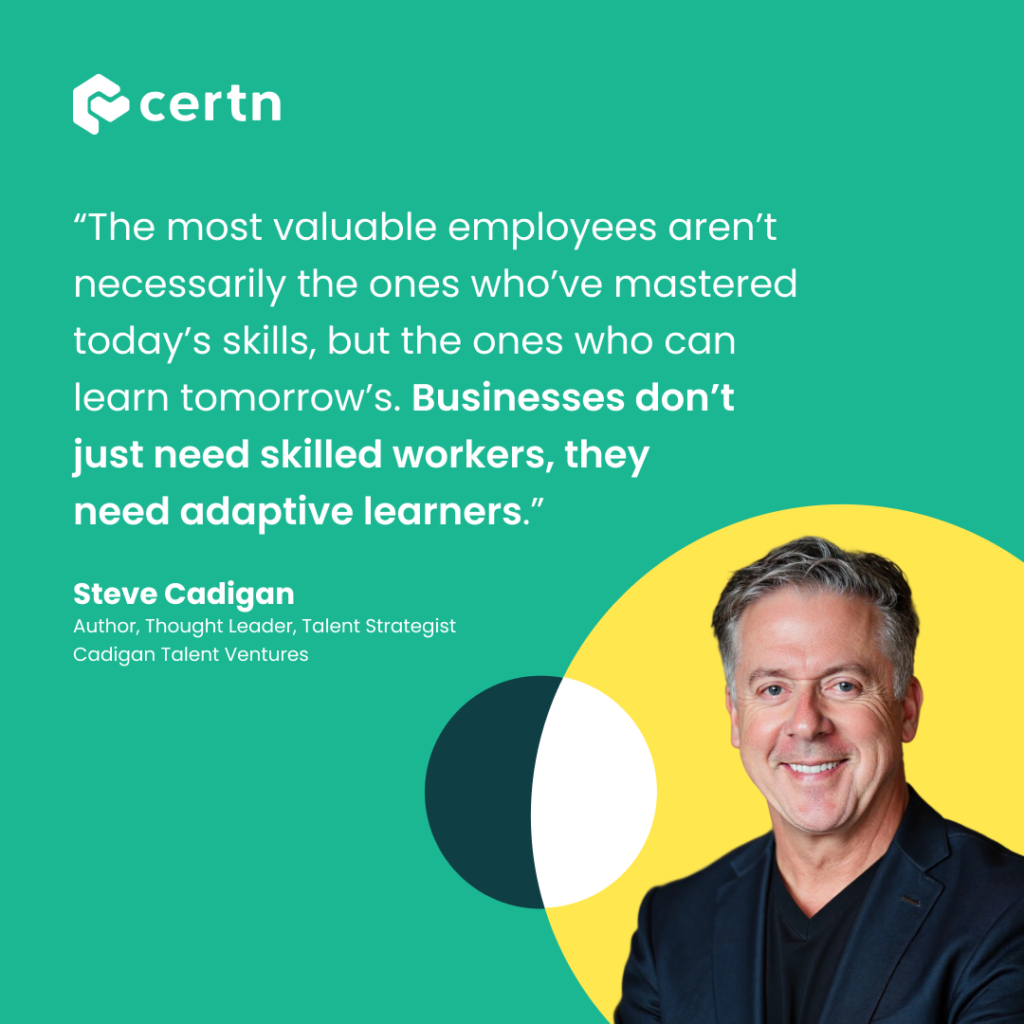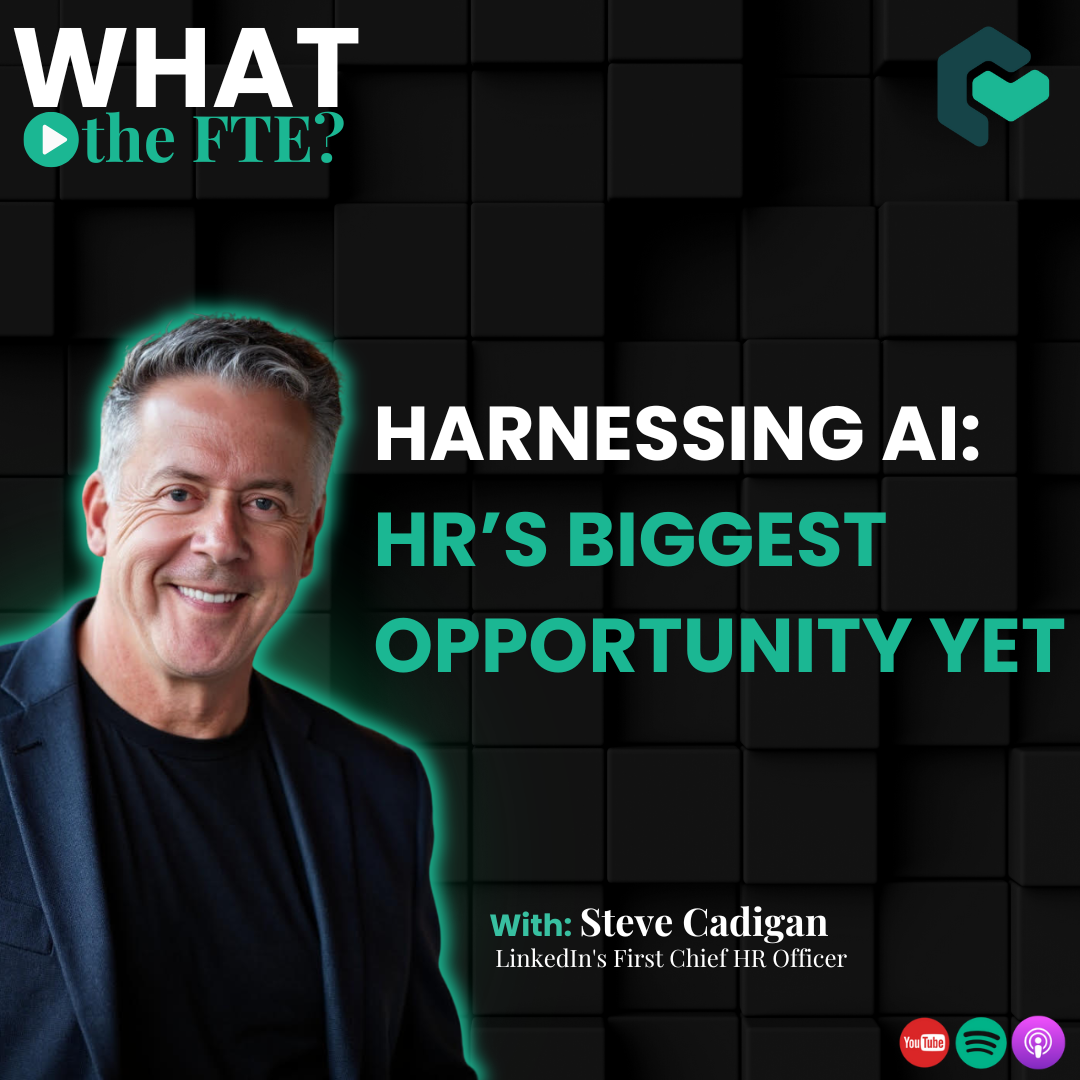In this week’s episode of What the FTE?, a podcast where we explore the tough questions surrounding the future of work, risk management, and employee experience, Certn’s CEO, Andrew McLeod, sits down with Steve Cadigan, LinkedIn’s first Chief HR Officer and a renowned talent advisor.
Steve advocates for HR leaders to embrace AI as a strategic tool to enhance talent management and organizational performance. Though, while AI presents immense opportunities for efficiency and scalability, the true potential of AI lies in how we balance its power with a human-centric approach.
—
AI is transforming the HR landscape, but it’s not just about automating processes; it’s about making smarter, data-driven decisions. As Gartner highlights, AI offers new ways for CHROs and HR leaders to enhance efficiency, innovation, and employee engagement. For years, HR leaders have wrestled with the question, “How do we get a seat at the table?” With AI, the question is shifting. Now, the real challenge is, “How do we lead the AI-driven transformation of work?
As AI reshapes skills development and employee experience, talent leaders have a choice: embrace AI as a strategic advantage or risk falling behind. But how exactly can HR become more strategic using AI? And, more importantly, how can AI help HR shed the “cost center” label and start being seen as a true business leader?
My conversation with Steve Cadigan, LinkedIn’s first Chief HR Officer and renowned talent advisor, is full of ideas, unpacking how HR leaders can harness AI to drive business impact, not just cut costs. Steve has been at the forefront of the talent space for over 30 years, from shaping LinkedIn’s early culture to advising some of the biggest companies on the future of work, so I was excited to get his views on how AI is shaking up HR in a way we’ve never seen before.
Let’s dive into the smart ways HR leaders are leveraging AI today, and how you can, too.
Using AI to Increase HR’s Strategic Impact
Many HR professionals see AI as a double-edged sword. On one hand, it promises to automate repetitive administrative tasks (and help shed the “paper pusher” stereotype), enhance decision making, and surface powerful insights. On the other, it raises fears about job displacement and diminishing the human element of work.
Steve argues that the real danger isn’t AI itself, it’s failing to adapt. Instead of seeing AI as a tool for eliminating jobs, he thinks HR leaders should focus on how it can enhance roles, unlock potential, and enable employees to do higher-value work. I couldn’t agree more.
“We need to look at AI not as a cost-cutting mechanism, but as a way to make jobs more dynamic, more interesting, and more impactful,” says Steve.

From Cost Center to Business Driver
For decades, HR has fought to be recognized as a business driver rather than a cost center. AI presents an opportunity to make that shift permanent, but only if HR leaders take ownership of AI’s implementation in the workplace.
AI is redefining how organizations measure success, moving beyond traditional hiring metrics to track employee learning velocity, adaptability, and long-term growth. Instead of asking, “How do we hire the best Python developer?”, forward-thinking HR leaders are asking, “How do we find people who can learn, pivot, and solve problems in an AI-driven world?”
Steve suggests HR teams double down on learning velocity—the ability to acquire and apply new skills quickly—as a core hiring and development metric.
“The most valuable employees aren’t necessarily the ones who’ve mastered today’s skills, but the ones who can learn tomorrow’s,” Steve explains. “Businesses don’t just need skilled workers; they need adaptive learners.”
Learning velocity is the new competitive advantage.
The Future of Talent Strategy: AI + Human Potential
Jobs are changing. There’s no doubt about it. To stay competitive, companies must move away from static job descriptions and embrace dynamic, skill-based talent models to find curious people who can solve complex problems quickly. Though, it’s also important to tap your existing employees.
At LinkedIn, Steve and his team used AI to identify employees with high learning velocity, equipping them with in-demand skills rather than always looking externally for talent. That approach created a pipeline of adaptable, future-ready employees, something he argues, more organizations should be prioritizing today.
HR’s AI Playbook: Where to Start
AI-powered HR platforms such as HiBob, Aura, and Cornerstone allow organizations to track workforce skills in real time, map internal talent pipelines, and make data-driven workforce decisions. While it’s easy to get overwhelmed by AI, especially when there’s a flood of new tools, software, and platforms hitting the market, the key is to start small.
Focus on one or two areas where AI can make the most impact, whether it’s improving your recruitment efficiency, predicting employee churn, or developing personalized learning pathways. From there, you can scale up your AI initiatives in alignment with your broader business objectives.
According to Steve, here are some other ways to show proactive leadership around AI:
- Build an AI Council – Take the lead in cross-functional AI discussions, ensuring AI is implemented ethically and strategically across the organization.
- Prioritize Learning Over Experience – Shift hiring strategies to focus on learning velocity rather than rigid qualifications. AI gives HR leaders the ability to use data to develop talent strategies that align directly with business goals, improving both employee outcomes and business performance
- Experiment and Iterate – AI is still evolving. Start with pilot programs in areas like recruitment, learning and development, and even performance management.
- Align AI with Business Impact – Some HR teams work and operate separately from the business strategy. But, as Maya Bellay highlighted in last week’s conversation on the RTO debate, the business strategy should always inform the HR strategy. HR needs to demonstrate an impact on things like growth, revenue and innovation. Focus on customer experience, workforce enablement, and competitive differentiation rather than cost-cutting alone.
- Communicate Openly with Employees – Address AI anxiety by positioning it as an enabler, not a threat. Provide learning opportunities so employees feel empowered, not displaced.
HR’s Moment to Lead
As made obvious through Steve’s comments in our conversation, the impact of AI on HR isn’t coming, it’s already here. Embracing AI is no longer optional; it’s a strategic imperative that will separate the innovators from the followers. HR leaders who lean into AI as a business enabler will drive the next generation of workplace transformation.
Certn’s approach to AI and automation-powered background checks mirrors this shift: faster, smarter, and built to support hiring teams, not replace them.
HR’s role has never been more important. The question isn’t if AI will change work, but how HR will lead the charge.
Tune into the full podcast: https://certn.co/podcast/





